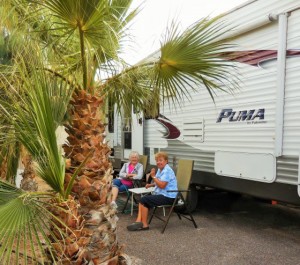
March 1, 2015 – Well here we are in Mulege, our 2nd day, it has become overcast and cooled off (25C), the forecast is for showers tomorrow. Today some folks went to mass in town, I took others into town for a little shopping and banking, still others went for lunch. For the most part the gang is in a relaxed and laid back mode. Lisa and I went for breakfast at the Hotel Serenidad with Ron & Andrea, it was tasty indeed and reasonably priced. Last night was lots of fun the gang went for Saturday night pork dinner at the Serenidad, a tradition for 50 years and we had great ribs. We arrived yesterday before lunch and headed out for an excursion at 2 pm. The drive thru town (dropped Lisa off with the laundry), then out to the Lighthouse where the Heroic Battle for Mulege with the US was won, then dropped by the Famous Loma Linda, next the former Prison, now Museum (unfortunately closed), then Jesuit Mission & Overlook, and finally a drive thru of the Orchard Village which continues to be devastated by successive hurricanes and floods. A busy day for sure.

Our drive from La Paz to our destination Puerto Escondido was for the most part uneventful and very enjoyable. After our lunch stop we headed east from Ciudad Insurgentes and as we were descending back to the Sea of Cortez an “A” Class with California plates started passing the Caravan, unfortunately somewhat recklessly as he also seemed to be racing a large Mexican flat deck truck. We gave them both lots of room as they passed however the Motorhome seemed not to know their rig and kept cutting people off. As they approached us the truck passed us and the Motorhome behind us quickly prior to a corner. As we finished the corner and headed into a long straight away I gave the Motorhome the left turn signal, slowed down; he had a mile of clear rode ahead to easily get past us. No matter, he cut us off anyway. Our biggest concern driving Baja is never the Mexican Truckers and Bus Drivers, it is RVers who cannot safely drive their own vehicles on Hwy 1.

We did arrive safely at our destination, Puerto Escondido Marina. On arrival at the security gate we were stopped as clearance had to be given from the office for us to park overnight. What happened next was unexpected. As we past the Tripui RV Park the owner jumped in his truck and raced past us to Puerto Escondido (I figured this out after). We were held up at the gate longer than usual as he was in the office attempting to stop us from using the facility parking lot. I learned this when he approached me at the Security Gate, telling us it was illegal to park at Puerto Escondido and he was going to call immigration and demanded that we stay at his RV Park. His efforts and approach were unappreciated and unsuccessful, I met with the staff personally in the office and the Caravan parked as usual. Later at the Happy Hour we were approached by a couple staff from the Hotel Tripui Restaurant. They brought menus and invited us for dinner, transportation provided at no cost. This approach worked well and eight (8) of us went for dinner.

After a spectacular sunrise the next morning we were off to Mulege and the Hotel Serenidad. We stopped at the newly rebuilt viewpoint overlooking Playa Juncalito and the Sea of Cortez, the sea was calm and beautiful. The Military check north of Loreto was very thorough and took a while. On our way we encountered a herd of goats crossing the highway and a water hazard at KM 62, the caravan had to cross into the oncoming lane and onto the shoulder to avoid the water filled crevices in the road. The rest of the drive was nothing but great scenery all the way to the Hotel.
Tomorrow we are off to Mario’s in Guerrero Negro, probably under cloudy skies and showers. Our last day in Baja California Sur.

Did you know?
The Totonac people, who inhabit the East Coast of Mexico in the present-day state of Veracruz, were the first to cultivate vanilla. According to Totonac mythology, the tropical orchid was born when Princess Xanat, forbidden by her father from marrying a mortal, fled to the forest with her lover. The lovers were captured and beheaded (sounds painful). Where their blood touched the ground, the vine of the tropical orchid grew. In the 15th century, Aztecs invading from the central highlands of Mexico conquered the Totonacs, and soon developed a taste for the vanilla pods. They named the fruit tlilxochitl, or “black flower”, after the matured fruit, which shrivels and turns black shortly after it is picked. Subjugated by the Aztecs, the Totonacs paid tribute by sending vanilla fruit to the Aztec capital, Tenochtitlan (now Mexico City).

Vanilla grows as a vine, climbing up an existing tree (also called a tutor), pole, or other support. It can be grown in a wood (on trees), in a plantation (on trees or poles), or in a “shader”, in increasing orders of productivity. Its growth environment is referred to as its terroir, and includes not only the adjacent plants, but also the climate, geography, and local geology. Left alone, it will grow as high as possible on the support, with few flowers. Every year, growers fold the higher parts of the plant downward so the plant stays at heights accessible by a standing human which also greatly stimulates flowering.

The Science
The distinctively flavored compounds are found in the fruit, which results from the pollination of the flower. One flower produces one fruit. V. planifoliaflowers are hermaphroditic: They carry both male (anther) and female (stigma) organs; however, to avoid self-pollination, a membrane separates those organs. The flowers can be naturally pollinated only by bees of theMelipona genus found in Mexico (abeja de monte or mountain bee). This bee provided Mexico with a 300-year-long monopoly on vanilla production, from the time it was first discovered by Europeans. The first vanilla orchid to flower in Europe was in the London collection of the Honourable Charles Greville in 1806. Cuttings from that plant went to Netherlands and Paris, from which the French first transplanted the vines to their overseas colonies. The vines would grow, but would not fruit outside Mexico. Growers tried to bring this bee into other growing locales, to no avail. The only way to produce fruits without the bees is artificial pollination which remains popular even in Mexico.

In 1836, botanist Charles François Antoine Morren was drinking coffee on a patio in Papantla (in Veracruz, Mexico) and noticed black bees flying around the vanilla flowers next to his table. He watched their actions closely as they would land and work their way under a flap inside the flower, transferring pollen in the process. Within hours, the flowers closed and several days later, Morren noticed vanilla pods beginning to form. Morren immediately began experimenting with hand pollination. A few years later in 1841, a simple and efficient artificial hand-pollination method was developed by a 12-year-old slave named Edmond Albius on Réunion, a method still used today. Using a beveled sliver ofbamboo, an agricultural worker lifts the membrane separating the anther and the stigma, then, using the thumb, transfers the pollinia from the anther to the stigma. The flower, self-pollinated, will then produce a fruit. The vanilla flower lasts about one day, sometimes less, so growers have to inspect their plantations every day for open flowers, a labour-intensive task. The fruit, a seed capsule, if left on the plant, will ripen and open at the end; as it dries, the phenolic compounds crystallize, giving the fruits a diamond-dusted appearance, which the French call givre (hoarfrost). It will then release the distinctive vanilla smell. The fruit contains tiny, black seeds. In dishes prepared with whole natural vanilla, these seeds are recognizable as black specks. Both the pod and the seeds are used in cooking. Like other orchids’ seeds, vanilla seeds will not germinate without the presence of certain mycorrhizal fungi. Instead, growers reproduce the plant by cutting: they remove sections of the vine with six or more leaf nodes, a root opposite each leaf. The two lower leaves are removed, and this area is buried in loose soil at the base of a support. The remaining upper roots will cling to the support, and often grow down into the soil. Growth is rapid under good conditions.

Price of Vanilla
Until the mid-19th century, Mexico was the chief producer of vanilla. In 1819, however, French entrepreneurs shipped vanilla fruits to the islands of Réunion and Mauritius in hopes of producing vanilla there. After Edmond Albius discovered how to pollinate the flowers quickly by hand, the pods began to thrive. Soon, the tropical orchids were sent from Réunion Island to the Comoros Islands Seychelles and Madagascar, along with instructions for pollinating them. By 1898, Madagascar, Réunion, and the Comoros Islands produced 200 metric tons of vanilla beans, about 80% of world production. According to the United Nations Food and Agriculture Organisation, Indonesia is currently responsible for the vast majority of the world’s Bourbon vanilla production and 58% of the world total vanilla fruit production. An estimated 95% of “vanilla” products are artificially flavored with vanillin derived from lignin instead of vanilla fruits.

The market price of vanilla rose dramatically in the late 1970s after a tropical cyclone ravaged key croplands. Prices remained high through the early 1980s despite the introduction of Indonesian vanilla. In the mid-1980s, the cartel that had controlled vanilla prices and distribution since its creation in 1930 disbanded. Prices dropped 70% over the next few years, to nearly $20US per kilogram; prices rose sharply again after tropical cyclone Hudah struck Madagascar in April 2000. The cyclone, political instability, and poor weather in the third year drove vanilla prices to an astonishing $550US per kilogram in 2004, bringing new countries into the vanilla industry. A good crop, coupled with decreased demand caused by the production of imitation vanilla, pushed the market price down to the $40US per kilogram range in the middle of 2005. By 2010, prices had returned to $20 US per kilo.



